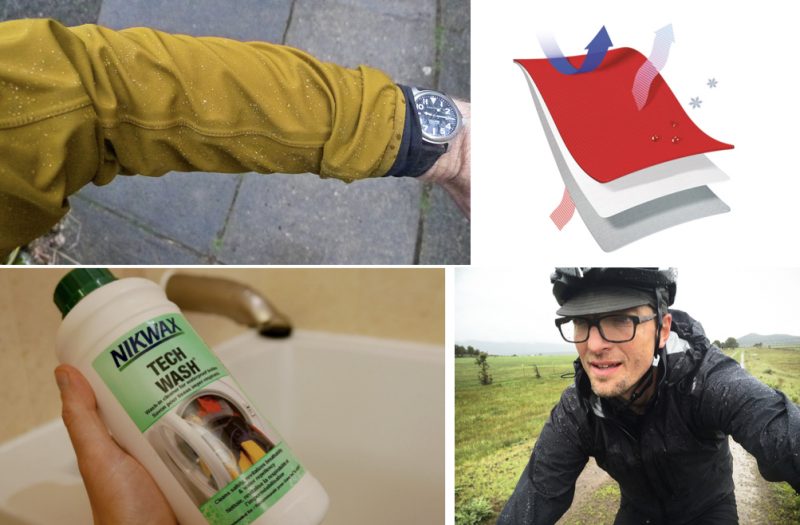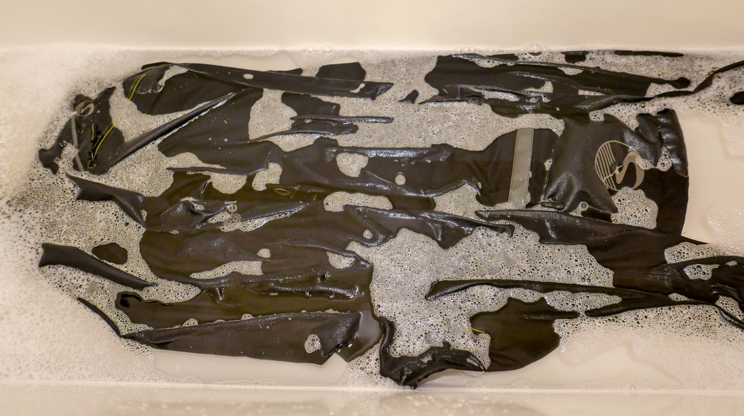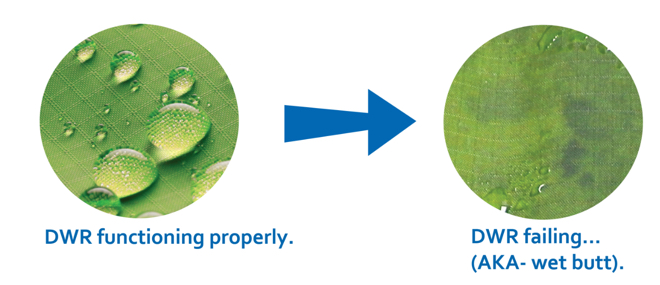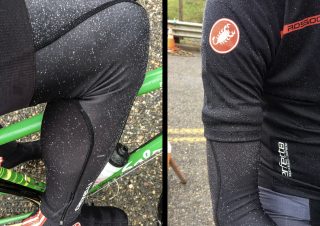
You know the feeling: It’s nice when it beads, but it doesn’t last forever.
(Photos: J. Maus/BikePortland and James Buckroyd/BuckyRides.com)
James Buckroyd is our Product Geek. See his previous stories here and delve deeper via his website BuckyRides.com.
We spend a lot of time choosing our gear carefully and as we know cycling gear is expensive! Especially when it comes to all-weather wear. But do you know how to keep your Rapha softshell going strong? Your Castelli Gabba still stretchy, or your favorite Showers Pass shedding through the spring? With a little investment in care you can keep your gear performing well.
It used to bead like water off a duck back, but now it pools water like a blocked drain. It’s often the latter situation that gets us thinking. Many times I have heard “It’s old, this is no longer waterproof,” but most of the time it has less to do with age and more to do with care. It’s a natural thought for us to wash and maintain cycling shorts, jerseys etc but when it comes to outerwear we treat highly technical stuff just like our casual jackets — not much thought, little washing, and little if any regular maintenance. This is where today’s high tech materials are different. They need maintenance to achieve the like-new performance.
The solution
Wash your gear! You’re hurting it more by not cleaning and maintaining it than by popping it in the laundry with the right detergent. Sometimes we feel that by washing our gear we are slowly wearing off the waterproofness, so we hesitate. Part of long-term care is also the re-application of waterproofing chemicals. Nikwax is one of many companies that understand one solution does not fit all, so they have a range of products for washing and refreshing the waterproofing of different cycling garments. I spoke with Nikwax’s Vice President of Marketing Heidi Dale Allen for this article and she shares some great tips below. I also spoke with the technical sales folks for a company that manufactures the breathable waterproof material called eVent, who shed a lot of light on complex technologies. Showers Pass Marketing Director Stephanie Leikas-Homolya also had some great insights on the topic.
This subject is deep in science, research and human perception, so if you want all the details, keep reading…
The details
The technical aspects can get deep, so its worth while defining a few terms beforehand:
➤ Membrane – The waterproofing layer of a multilayer material, sometimes called the barrier. Blocks water from coming in yet lets out moisture from your body (think body steam). Typically it’s a thin polyurethane material designed in different ways, with or without perforations. Because the membrane is delicate it is often sandwiched between other fabric layers for protection.
➤ DWR – Durable water repellent coating applied to the top surface of a material to repel water. Applied to a single layer, but can be used in multilayer materials. This coating helps shed water by not allowing droplets to stick. It’s controversial because the toxic chemicals used have been traced back to the water sources for humans. Standards are ever changing but this coating wears off and gets into our water sources.
➤ Laminate – Multiple layers stuck together.
➤ Breathability – The ability of a fabric to transfer moisture vapor, in this case, the moisture vapor created by your body to outside the garment. This is quantifiable in labs tests of different kinds.
The gear
First you have to think of fabric a little differently, as fabric having thickness made from layers. It could be one, two or three layers thick. Modern materials are made of layers, these layers are hard to see with the naked eye and when a garment is sewn nicely together, but if you were to cut it apart carefully you would see several layers.
In manufacture, these layers have different physical properties and are made from different materials bonded together under heat and pressure. The top layer might be really rugged, the bottom layer softer since it’s near the skin. These materials are called laminates.
You may see logos on garments from companies which specialize in this fabric production such as Gore, Polartec and eVent. Different cycling brands use different sources of material. For instance your Castelli cycling jacket may use a Gore material and Rapha might use a Polartec. The Portland based Showers Pass develop their own laminate materials direct at their manufacturing sources. These companies all make materials with some form of a membrane, the tech and performance details vary from each company.
On the simplest end of things is a single layer material, where a DWR is applied. These are normally “shower protection” at best, for cyclists, this might be in the form of a light wind jacket or leggings. Moving up, most jackets above a $100 price point have some type of laminate material with a membrane. Most materials are three layers thick and they contain a membrane in the middle. An outer layer that is designed to be durable and abrasion resistant, often this is DWR treated to help shed water, in the middle the membrane, then they have a backer on the inside that protects the membrane and also feels nicer on the skin. Each layer has a different purpose, the outermost layer to shed rain and provide protection to the delicate membrane. The membrane to allow vapor to pass from one side and block water from the other and the baker material to protect the membrane, add structure and feel nice next to the skin.
The care
To get the best from your gear, cleaning and re-waterproofing are really important. Cleaning and waterproofing are not the same. It sounds obvious but as soon as you start looking for products to help you it can become confusing. Cleaning removes sweat and dirt. Waterproofing attempts to restore water repellency on the outer fabric layer.
Cleaning
Performance and contaminants cause havoc, dirt and sweat are ultimately the enemies of your jackets material, they counteract the performance properties. By washing you are removing the dirt from the surface of the material and sweat from the weave and pores of the material. Some of this dirt is really small, might not even look dirty, could be all the dust you just shred from your local Firelane 5. When it rains, the dirt traps or helps retain some moisture at the top surface of your material, blocking the pores that let your body heat escape and also wetting the material for longer. Effectively doing two things you don’t want it to do.
A detergent is not a detergent / What should I wash with?
Manufacturers don’t want you to take risks in ruining your jackets or what have you. Traditional detergents can block the pores in the membrane and fabric of your gear, thus removing functionality the same way dirt does. Normal clothing detergents have not been chemically designed to clean micro pores so for best results we turn to detergents that can remove dirt and won’t clog. Manufacturers like Nikwax and Granger design detergents specifically for washing high tech outdoor gear and are worth the cost.
How often to wash?
That’s a good and somewhat subjective question that relates to how much and how hard you use the garment. For example, I don’t use these outer garments every day but maybe twice a week, and under high performance conditions, meaning I am riding in rain and the garment is dirty whilst ‘m performing at a high rate, sweating and riding with high intensity, so a proper washing every other week seems reasonable.
This Showers Pass Spring Classics jacket had not been washed for four or five light uses, no heavy dirt. Yet the colour of the water showed that a lot of dirt was removed from the jacket. If your jacket is more exposed to dirt, maybe more off-road conditions, you might want to wash after two uses. For a jacket with frequent use but not much dirt, maybe not much sweat, i.e. a commuting situation, consider washing it every two-three weeks for optimum performance.
Insider tips from the experts

The experts: (Top) Glenn Crowther and Dave Wilson from eVent Fabrics, Heide Dale Allen from Nikwax, and Stephanie Leikas-Homolya from Showers Pass.
Three tips from Heidi at Nikwax:
➤ Clean more frequently than you waterproof. It will save you money, as most of the time it is dirt, oil and sweat that is compromising the water-repellency and cleaning will sort that right out. You can likely clean 3-5 times before needing to add waterproofing.
➤ Always read your garment’s care label! Some items should be washed with cold water, some with warm. Some can be tumbled-dried, and others cannot. Nikwax works great in any water temperature, and does not need heat to activate, making it effective on all types of cycling wear.
➤ Never use fabric softener or dryer sheets on any type of technical clothing, as they leave behind all sorts of residues that hinder performance.
Stephanie from Showers Pass:
➤ Check your use and care, for Shower Pass we have a page on our website with full care instructions.
➤ Be careful with machine drying garments – many brands do not recommend applying heat to waterproof garments after washing as it can damage the seam tape.
Renewing Waterproofing
When talking about renewing, we are referring to refreshing the coating that makes the fabric slippy to sheds water this works to help the membrane on the inside of the fabric. The DWR chemical that is on the outermost fabric and over time DWR’s can wear off from abrasion and from frequent washing. At some point you might experience a lack of water beading on the surface and this could be a strong sign that the DWR coating is coming off.
Stretchy or not?
One of the important differences when retreating fabrics for water repellency is using the correct treatment for specific material and that requires knowing what fabric you have. An easy way to find out what you have is to understand the concept of a stretch, stretch comes from how the material is made, loops of thread or strands that are woven over each other, in short Knits or Wovens. The cycling gear market has a mixture of types. Generally speaking a “softshell” is a knit, where a “hardshell” is more likely to be a weave/woven fabric. They stretch in different directions, a knitted material generally stretches in more directions and tend to give a more form-fitting look. Don’t mix this up with your Granny’s crocheting, the knits of today are very advanced. A good reference here is a Showers Pass jacket, which is a woven fabric, often with a high-performance membrane made by eVent or similar technology. When you try and stretch this fabric you will notice it doesn’t stretch much, or only stretches in one direction. Manufacturers are using clever design when incorporating woven material by combining panels of stretchy knit material to make the garment fit better. Showers Pass are very good at this in their Spring Classics Jacket.
Here’s how to identify your weatherproof gear…
➤ When using two hands and pulling the material, Does the material stretch easily in many directions? Does the material lay easily? If yes, you probably have a knit fabric or softshell.
➤ Does the garment have a crispy top surface, does the garment feel less flexible in one stretch direction than the other? If yes, it’s likely a woven garment also known as hardshell.
Cycling legwarmers and armwarmers tend to be of a knit and there are quite a lot on the market now with a DWR coating. When it comes to rain jackets there’s is a big mix out there. The classic look is a hardshell, a.k.a. similar to a Showers Pass. But there are many jackets now that are softshells like the Castelli Gabba Jacket or even a more weather resistant jersey. Now after having identified this you can select the waterproof retreatment that is designed for your fabric.
TX Direct by Nikwax is waterproof renewal designed to work best on a a hardshell fabric. Nikwax treatments coat fabric with a network of elastic TX.10i water-repellent molecules. They bond to anything that is not water-repellent, but leave the spaces between fibres open and breathable. Nikwax treatments can flex and move with the fabric and leather fibres, they make several specific solutions for hard and soft shells. TX Direct is aimed more towards hardshells and can be applied by hand washing or in a washing machine. SoftShell Proof is aimed towards the knit fabric types like a Castelli Gabba or a Rapha Softshell. Nikwax also has version of the TX.Direct and SoftShell Proof in a spray-on application, this is good for materials which are backed by a wicking/fleece back. I have seen some softshell gear with a lofty/fleecy inside which would be perfect for this, keeping the wicking properties in tact and replenishing the outside DWR layer.
Ecological implications
Clothing manufacturer applied DWR’s are a large point of contention in the outdoor industry because byproduct chemicals in DWR’s production called perfluorochemicals (PFCs) have been found to be toxic to animals and humans and are starting to enter the water system. In order to reduce this toxicity, new regulations have been made so chemicals are labelled and controllable. Companies like Patagonia have been advocates in removing c8 type DWR’s and moving to cleaner c6 DWR coatings (read more here). Nikwax treatments coat fabric with a network of elastic TX.10i water-repellent molecules to replenish the DWR and are PFC-free, water-based and non-toxic an only supplied in non aerosol containers.
You can help the environment by looking after your gear, choosing the right treatments and extending the life of your products will help against negative environmental impacts.
The bottom line
The biggest fail is often lack of washing. Wash your gear often, use the right detergents for the specific materials (don’t use your regular Tide detergent), re-apply waterproofing when needed, and you will find many years of performance from your cycling gear. Doing both these things requires a little more time investment that will pay off.
Links for more research
Laminates
– eVent Fabrics Technology
– Gore Windstopper
– Polartec
Treatment products
– Nikwax product selector tool
– Hydrobead
– NeverWet hydrophobic coating spray
– REI tips for DWR
— James Buckroyd – Buckyrides.com
Never miss a story. Sign-up for the daily BP Headlines email.
BikePortland needs your support.
The post Keep it waterproof: A guide to getting more out of your gear appeared first on BikePortland.org.
from BikePortland.org http://ift.tt/2DesGwP







No comments:
Post a Comment